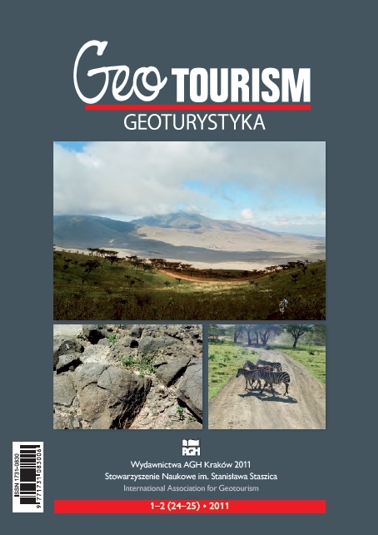The Ngorongoro Crater as the biggest geotouristic attraction of the Gregory Rift (Northern Tanzania, Africa) – geological heritage
DOI:
https://doi.org/10.7494/geotour.2011.24-25.27Keywords:
volcanoes, Ngorongoro, Tanzania, Africa, Gregory Rift, East African Rift System, geotouristc (geological) attractionsAbstract
The Ngorongoro Crater is the largest unflooded and not destroyed collapse volcanic caldera of the shield volcano on Earth. It attracts many visitors each year not only because of the undoubted wealth of the wildlife and breathtaking views, but also due to the geotouristic attractiveness of this definite location. The Crater is in fact a specific example of geological processes, relevant to the development of planet Earth. In a relatively small area one can observe rocks of different types and ages: Precambrian igneous and metamorphic rocks, volcanic rocks formed in the Pliocene, Pleistocene, and even nowadays, as well as sedimentary rocks, up to those currently forming within the caldera floor. The origin and development of the Ngorongoro volcano, and lately caldera, is closely related to the activity of rifting processes occurring along the Gregory Rift, belonging to the East African Rift System. It represents one of the three arms of the Afar triple junction associated with the located here hotspot. Due to the geotouristic attractiveness, as well as a richness of living nature and archaeological sites with discoveries of our ancestors, which illustrate an important stage in the history of mankind, the area of the Ngorongoro Crater was designated a UNESCO World Cultural and Natural Heritage.Downloads
References
Bagdasaryan, G., Gerasimovskiy, V., Polyakov, A., Gukasyan, R., Vernadskiy, V., 1973. Age of volcanic rocks in the rift zones of East Africa. Geochemistry International, 10: 66–71.
Barker, B.H., Mitchell, J.G., Williams, A.A.J., 1988. Stratigraphic geochronology and volcano-tectonic evolution of the Kedong-Naivasha-Kinangop region, Gregory Rift Valey, Kenya. Journal of the Geological Society, London, 145: 107–116.
Burke, K.C., Kidd, W.S.F., Turcotte, D.L., Dewey, J.F., Mouginis-Mark, P.J., Parmentier, E.M., Şengör, A.M., Tapponnier, P.E., 1981. Tectonics of basaltic volcanism. In: Basaltic volcanism on the terrestrial planets (Basaltic Volcanism Study Project). Pergamon, New York: 803–898.
Dawson, J.B., 2008. The Gregory Rift Valley and Neogene-Recent Volcanoes of Northern Tanzania. Geological Society, London, 102 pp.
Foster, A., Ebinger, C., Mbede, E. & Rex, D., 1997. Tectonic development of the northern Tanzanian sector of the East African Rift System. Journal of the Geological Society, 154: 689–700.
Grommé, C., Reilly, T., Mussett, A.I, Hay, R., 1970. Tectonic development of the northern sector of the East African Rift System. Journal of the Geological Society, London, 126: 689–700.
Hay, R.L., 1976. Geology of the Olduvai Gorge. University of California Press, Berkeley, 203 pp.
James D.E., 1966. The carbonatites of Tanganyika: a phase of continentaltype volcanism. DIC thesis, Imperial College, London.
Mollel, G., Swisher, III C., Feigenson, M., Carr, M., 2008. Geochemical evolution of Ngorongoro Caldera, Northern Tanzania: Implications for crustmagma interaction. Earth and Planetary Science Letters, 271: 337–347.
Pickering, R., 1965. Ngorongoro. Tanzania Geological Survey Quarter Degree Sheet 53.
Pickering, R., 1994. Ngorongoro’s Geological History. Ngorongoro Conservation Area Authority, Arusha, 52 pp.
Wood, C.P., 1968. A geochemical study of East African alkaline lavas and its relevance to the petrogenesis of nephelinites. PhD thesis, University of Leeds.
Żaba, J., 2005. The Kilimanjaro Volcano – geotouristic attraction in Africa. Geotourism, 1 (2): 3–12.
Żaba, J., Gaidzik, K., 2011a. The Ngorongoro Crater as the biggest geotouristic attraction of the Gregory Rift (N Tanzania, Africa) – geographical setting. Geotourism in preparation, 1–2 (24–25): 3–26.
Żaba, J., Gaidzik, K., 2011b. The Ngorongoro Crater as the biggest geotouristic attraction of the Gregory Rift (N Tanzania, Africa) – geotouristic valorization, touristic development and hazard. Geotourism, 1–2 (24–25): 47–64.
Downloads
Issue
Section
License

The content of the journal is freely available according to the Creative Commons License Attribution 4.0 International (CC BY 4.0).


